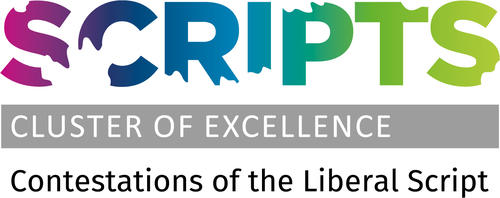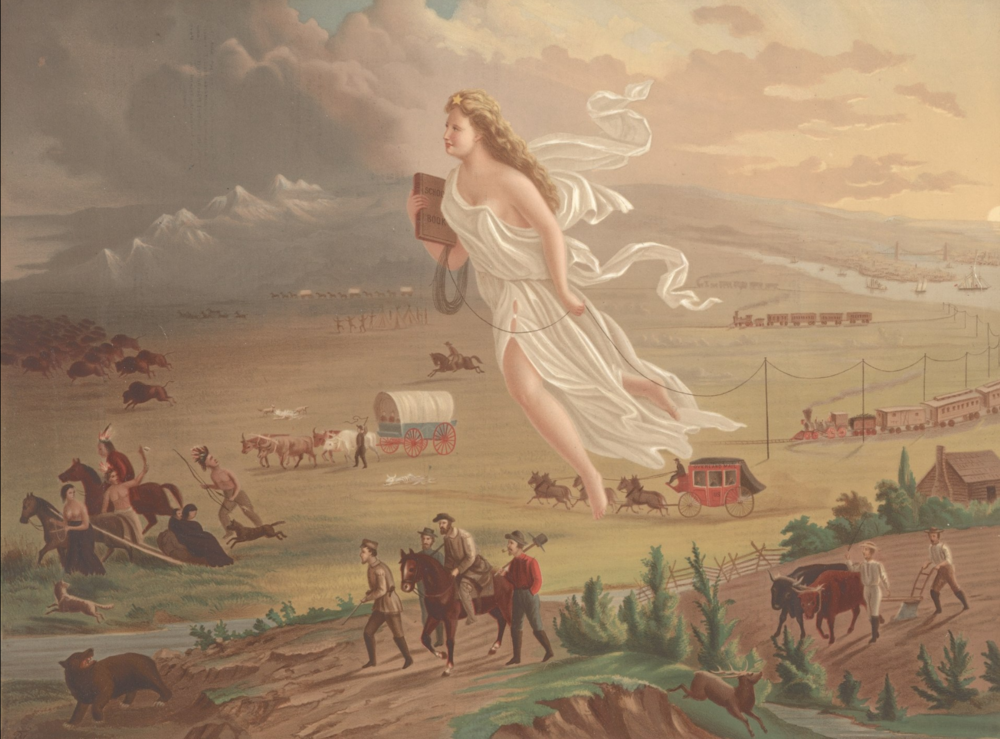Masculine Nations, Female Personifications – The Gendered Imagery of Nationalism
by Johannes Heß and Tobias Klee
№ 9/2021 from Dec 02, 2021
Feminist scholars have long identified the masculine nature of nation-states. Nevertheless, portrayals of the nation often depict it as female. We examine this phenomenon of masculine dominance and female personifications. To this end, we explore the ties of the modern nation-state to European imperialism, and its dependence on the connection of race and gender to justify white patriarchal hierarchies. We also investigate the use of familial images to tie the nation to a territory. This leads us to the conclusion that the images of fictional women used to personify the nation are another aspect of the masculine nature of (liberal) nations.
If nationalism were a gallery, its walls would be lined with paintings of serious men and scantily clad women. Examples include Liberty Leading the People by Eugène Delacroix (1830), depicting Marianne leading French fighters with her breasts prominently on display, or American Progress by John Gast (1872), showing Columbia leading the American frontiersmen, bringing the light of the dawn and telegraph lines to the West. How come that, at a time when women’s political participation was still very much contested, we find these prominent female figures symbolising the nation?
The origin of the modern European nation is tightly connected to European imperialism. By the end of the 19th century, the spectre of ‘degeneracy’ captivated European societies. Underpinned by Social Darwinism, degeneracy theory postulated that different areas of the world hosted humans of differing evolutionary stages. Within this framework, Africa was home to the underdeveloped races, giving European empires a pretext for their “mission to civilise”. But European societies, like Germany, France, Britain, or Spain, also applied the concept of degeneracy internally. Physicians, such as Max Nordau, attributed degeneration to moral and physical decay, nervousness, and the lack of self-restraint. Bénédict Morel described the degenerate body as a deviation from a healthy norm (Mosse, 2020). While a healthy body commanded the ability to control its sexual impulses and to maintain its modesty, the degenerate body represented weakness, impressionableness, as well as the incapacity to control its instincts.
Degeneration became a way of contrasting the “civilised” European nations with their colonial subjects. Black people, thus went the European conviction, possessed childlike brains, prohibiting them from acting rationally and controlling their emotions, attributes also associated with the feminine physique. Only the white male body commanded rationality and self-control. European men therefore represented the evolutionary forces of progress, while women and non-white peoples represented conservativeness and backwardness. From an imperial European point of view, degeneracy theory aligned women with “inferior” races, while it feminised indigenous Africans. As Stepan puts it “lower races represented the 'female' type of the human species, and females the 'lower race' of gender” (Stepan, 1986).
On an international level, gender served to establish and justify external borders between the masculine, “civilised” imperial centre, and the feminine, barbarian periphery. European nations aspired to prove their masculinity, and to reaffirm their status as civilised by acquiring and maintaining colonies. While in this worldview, women, and anyone who counted as “degenerate” (Black, poor, disabled, or mentally ill people, Jews) exhibited similar characteristics, the latter could still be considered masculine, albeit exhibiting a deviant, evolutionary stagnant masculinity. They represented the contrast to idealised imperial masculinities. Advertisements of colonial enterprises in Victorian Britain often feminised Black men, by presenting them as wearing feminine clothing, or as servants to white men, a role also associated with women (McClintock, 1995).
Accordingly, gendered concepts justified colonialism, and explained societal processes as laws of nature. Under the guise of alleged biological objectivity, sex/gender (as there existed no differentiation) and the use of Social Darwinist arguments established the world as deterministic and teleological. An imperial people had to be masculine to be considered civilised and vice versa. In the late 19th and early 20th century, this conviction carried over to the imperialist nation-states themselves. A civilised nation exhibited masculine qualities by externally possessing colonies, and internally commanding a rational, self-controlled people.
Given this intimate link between masculinity and the nation, how do we explain the phenomenon described above: That, when it comes to personifying the nation, nationalists always reach for the female form? A nation’s primary purpose is providing identification for the people who belong to the nation. To that end, a nation needs to demarcate a boundary, by determining who is ‘in’ and who is ‘out’, most literally in the form of a border (Yuval-Davis, 1993). An important tool in that regard is the process of homeland making (Kaiser, 2002).
Homelands are rhetorically constructed, giving the national population an exclusive “spatial identity” (ebd.). This act not only manifests itself geographically, but also on an institutional and cultural level, via laws, practices, education, language, and on a temporal axis, in which the homeland is imbued and marked with historical meaning through memorials, monuments, ancient sites, or museums. The spatialisation of the nation has a cohesive function, uniting a people via their territorial identity. It establishes an ancient, long-lasting tie of an ethnicity to a specific geographic area. Kaiser postulates: “Narrating nation and homeland [...] naturalizes the linkage between blood and soil, and so strengthens the legitimacy of nationalist claims to the land itself.” (ebd.).
The ultimate bond between a people and its homeland is forged by attaching gendered markers to the national territory. There is perhaps no greater portrayal of this blood-and-soil tying of people to homeland than the gendered symbol of the mother giving birth to the nation's people. We are all familiar with the representation of nations in the form of female national personifications—a Britannia, a Germania, a Mother Russia. Images of national personifications are a phenomenon that took off in the 18th and 19th century (Pezzoli-Olgiati/Höpflinger, 2015) closely following the emergence of nationalist movements. But how can women be side-lined if they are the central embodiment of the nation?
While one is hard-pressed to think of male allegorical figures of the nation outside of John Bull or Uncle Sam, it’s easier to find men who represent it: Simón Bolívar, national hero of many South American nations, George Washington of the USA. But their potential as unifying figures is limited by their basis in historical fact. Male national icons are more concrete and exclusionary, while female national representations are unifying figures, not least of all because of their allegorical nature (Kaiser, 2002). In the words of Mateos Sillero put: “Man is an individual, woman, to the contrary, has no other existence outside of the generic.“ (Mateos Sillero, 2014).
While male national representations celebrate the contributions of real men to the nation, women who occupy the national imagination never existed. Simón Bolívar was real, but no bare-breasted woman led French fighters across a barricade in 1830. Female national personifications exemplify attributes selected by men. In their depictions, we can best see the limited roles available to women: Women reproduce the nation biologically and ideologically, they signify and reproduce boundaries between groups (Yuval-Davis,1988).
As biological reproducers of the nation, women’s role hinges on motherhood. This is what “blood and soil” means: a connection between people and land forged by common ancestry. The female national allegory functions similarly for the nation’s citizens. As Boehmer points out:“the image of the mother invites connotations of origins [...] and rests upon the frequent, [...] ‘natural’, identification of the mother with [...] the national territory” (Boehmer, 2005), while the term fatherland rather appeals to the ideals of duty and loyalty. National narratives relegate women to the apolitical sphere of the family (Yuval-Davis, 1993), ascribing them the purpose of reproduction and protection of cultural traditions, while they place men at the nation's forefront (Nagel, 1998), as pioneers of art, military, science, or statecraft. When 19th century Punch cartoons depicted Britannia, her ability to partake in politics rested on her ability to “discipline” India (Helmreich, 2003)—like a mother would.
As signifiers and reproducers of the boundary between groups, women embody the idealised qualities of the nation (Pezzoli-Olgiati/Höpflinger, 2015), those deserving protection. They represent the national honour. This holds existing women to an impossible standard: they must be young, beautiful, battle-ready yet feminine. The national personification’s exaggerated beauty undercuts the strength that wielding a weapon confers upon her. Like a modern super heroine, she must be strong but not in a way that endangers her desirability for men.
Thus men can easily find themselves in the national history, while women are only welcome when they are mothers, or fictional. Nations are masculine realms, without space for women as political agents. The frequent representation of nations as women is simply another symptom of nation-states marked by European imperialism, their investment in gendered imagery and binary understandings of gender is a means to establish, justify and protect white masculine dominance.
Why is this important for us, studying the liberal script? The concept of the nation-state is foundational for liberalism. We use the language of nationalism every day: in national news broadcasts, in national flags on public buildings (Billig, 1995) and we enjoy certain rights and benefits that are dependent on our nationality (Tamir, 1993). Given our arguments, we have to question the inclusiveness and equality liberal nation-states offer to the national populace. We have to investigate the mechanisms by which people are included in or excluded from the nation. This concerns questions of external borders, such as migration, as well as the question of equal rights within states. Gender division is not incidental to that but a core exclusionary mechanism of nationalist ideology. By attaching the nation to the pseudo-biological marker of gender, nationalists (and, living in liberal nation-states, we all are, to a certain extent, nationalists) transform the nation into something immutable, something natural. Its artificial construction disappears into the fog of a mythical past. It becomes an anthropological constant with which we continue to structure our lives today.
Boehmer, E., 2005. Stories of women: gender and narrative in the postcolonial nation. Manchester University Press, Manchester.
Billig, M., 1995. Banal Nationalism. SAGE Publications, London.
Helmreich, A., 2003. Domesticating Britannia: Representations of the Nation in Punch: 1870-1880, in: Art Nation and Gender. Routledge, London, pp. 15–28.
Höpflinger, A.-K., 2015. Imagining a Nation. The Civil-Religious Role of Female State Personifications, in: Religion in Cultural Imaginary. Explorations in Visual and Material Practices. Nomos, Berlin, pp. 55–77.
Kaiser, R.J., 2002. Homeland Making and the Territorialization of National Identity, in: Ethnonationalism in the Contemporary World. Routledge, pp. 229–247.
McClintock, A. (1995) Imperial leather : race, gender and sexuality in the colonial contest / Anne McClintock. New York [u.a: Routledge.]
Mateos Sillero, Sar. “Construcción de La Feminidad Normativa y Sujeto Político.” Investigaciones Feministas 4 (2014): n. pag. Web.
Meyerowitz, J., 2008. A History of “Gender.” Am. Hist. Rev. 113, 1346–1356.
Mosse, G.L., 1985. Nationalism and Sexuality. Respectability and Abnormal Sexuality in Modern Europe. Howard Fertig, New York.
Nagel, J., 1998. Masculinity and Nationalism: Gender and Sexuality in the Making of Nations. Ethn. Racial Stud. 21, 242–269.
Stepan, N.L., 1986. Race and Gender: The Role of Analogy in Science. Isis 77, 261–277.
Tamir, Y. (1993) Liberal nationalism / Yael Tamir. Princeton, NJ: Princeton Univ. Press.
Yuval-Davis, N., Anthias, F., 1989. Woman-Nation-State. Macmillan, Houndmills, Basingstoke, Hampshire.
Yuval-Davis, N., 1993. Gender and Nation. Ethn. Racial Stud. 16, 621–632.
Johannes Heß and Tobias Klee are project doctoral researchers in the SCRIPTS Project ‘Gender, Borders, Memory’. Tobias Klee has an M.A. in History. His research focusses on the influence of gender on the construction of Catalan national identity. Johannes Heß holds an M.A. in political science and conducts research on gendered national identities. In the project ‘Gender, Borders, Memory’ they investigate how gender structures the inclusiveness and exclusiveness of nations.

